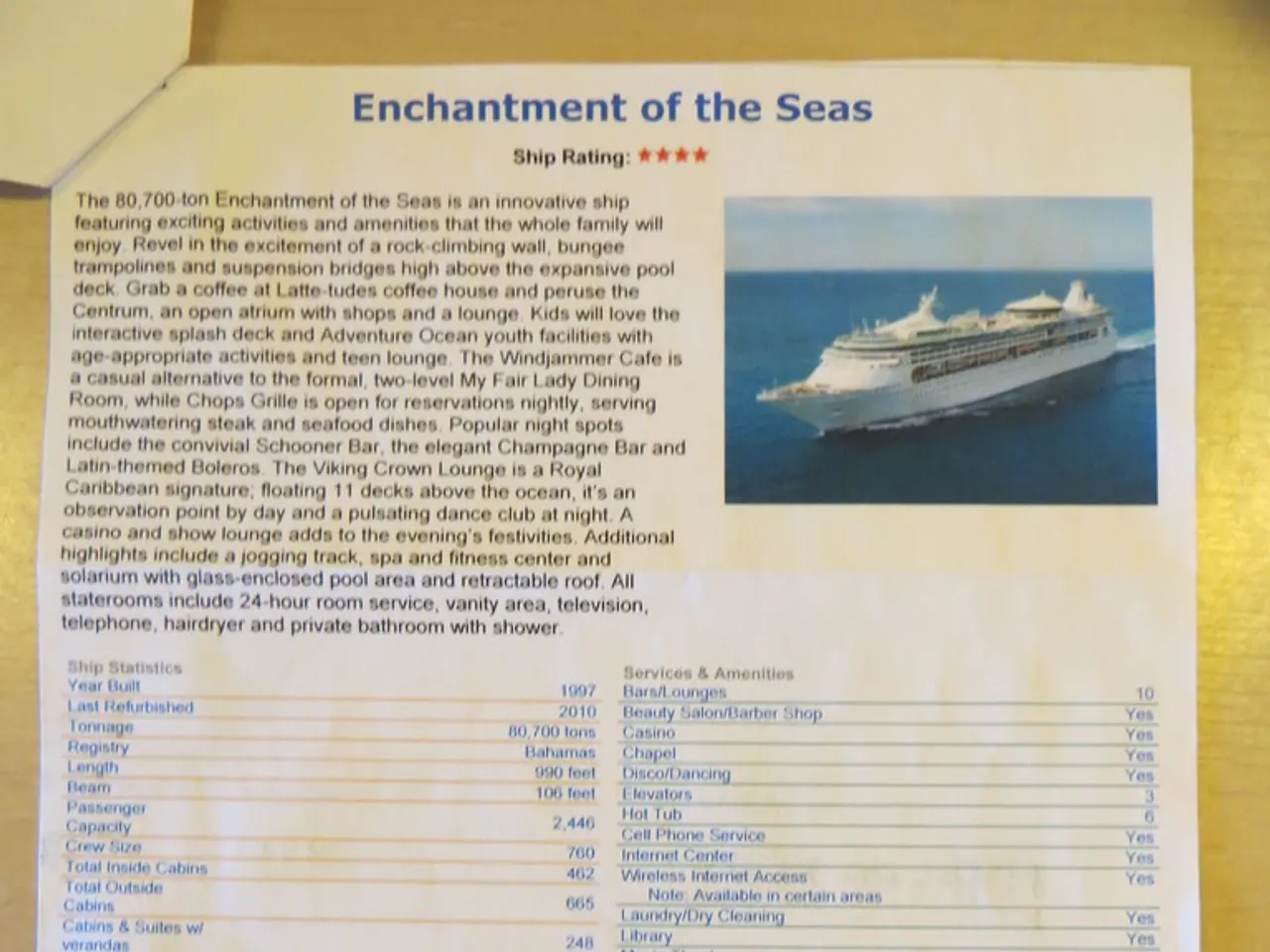Exploring Depths and Scales: An Overview of Hydrographic Surveys and Their Selection Criteria
The method of mapping the topographical features of the sea floor has undergone significant transformations over the years. The accepted approach involves traversing the area with parallel lines of soundings, with the distance between them determining how much is learned and what might be overlooked.
One of the challenges in creating navigation charts for underwater features is the unexpected slopes, often less than 30°, and the presence of coral heads, rocky outcrops, and exceptional cases like needle rocks, such as Cook Rock in Cook Strait, Avocet Rock in the Southern Red Sea, and a rock found off the Peninsula south of Reykjavik in Iceland, which rise to the surface.
The journey from manual lead line soundings, used for centuries to create initial reef and shoreline charts, to modern sonar and electronic techniques has been a long and fascinating one. The labor-intensive, slow, and limited coverage method of lead line soundings was replaced by wire-drag surveys in the late 19th and early 20th centuries, which improved hazard detection by spanning a wire between two vessels and towing it just above the sea floor.
The mid-20th century brought about single beam echo sounding, a significant leap forward due to its high efficiency and accuracy in depth measurement along survey lines. This was followed by multibeam echo sounders and side-scan sonar, which allow swath mapping of large sea floor areas, providing dense and detailed bathymetric data.
More recently, satellite altimetry and remote sensing have come into play, indirectly estimating sea floor topography by measuring sea surface height variations caused by gravitational anomalies of underwater features. Although less precise for detailed nautical charts, they provide broad bathymetric data complementing direct surveys.
Modern nautical charts from organisations like NOAA include metadata and diagrams representing the quality and confidence of hydrographic data, reflecting the survey method, age, and technology used. This guides mariners in assessing navigation risks based on survey detail and recency.
Today, hydrographic data is integrated into digital formats, allowing for dynamic display of survey quality information on electronic devices. This evolution from manual, point-based measurements to extensive, high-resolution, and technology-driven surveys has significantly improved the safety and accuracy of navigation charts over time.
One notable example is the Sea Green Shoal, reported by a minesweeper fouling her sweeps on it during the war and the object of an investigation in 1946. It was half a mile in diameter at its base and rose 120 feet to a rounded top.
Mariners must be aware of out-of-date surveys on their charts, but they can take comfort from the care and devotion brought to their task by the surveyors of the last century. Their soundings, though sparse by modern standards, have meant that they missed but few shoals dangerous to surface navigation.
The main purpose of a navigation chart is to show what lies under the water, avoiding unwittingly taking the ground and assisting in determining a ship's position. Depths on navigation charts are usually in greater profusion than comparable spot heights of land maps, supported by contour lines called fathom lines at sea.
The manuscript presented here is a reprint of a 1955 paper published in The International Hydrographic Review.
[1] [Source 1] [2] [Source 2] [3] [Source 3]
- The advancements in hydrographic survey techniques over the years play a significant role in the field of science, providing valuable data for navigation and exploring the ocean floor.
- Health-and-wellness is not the first association that comes to mind when thinking about hydrographic survey, but understanding sea floor topography can indirectly contribute to the study of marine life and its impact on human health.
- Finance is underpinned by the accurate interpretation of data from various sources, with hydrographic data finding its place in business decisions related to shipping routes and determining insurance premiums, thus ties into personal-finance and investment considerations.
- The exploration of space-and-astronomy is not limited to the universe outside our planet, as hydrographic surveys help in understanding Earth's climate and weather patterns.
- Lifestyle in the broad sense is continually evolving due to advancements in technology, and hydrographic survey technologies have played a significant role in this change, making navigation safer and more accessible.
- Education-and-self-development is fostered when one gains a better understanding of the world around them, and hydrographic survey results contribute to that increased awareness and appreciation.
- Sports like sailing, yachting, and many others thrive on accurate mapping of sea floor features, and hydrographic surveys help in this quest by ensuring safe and efficient routes for those who enjoy the thrill of competition on the water.




